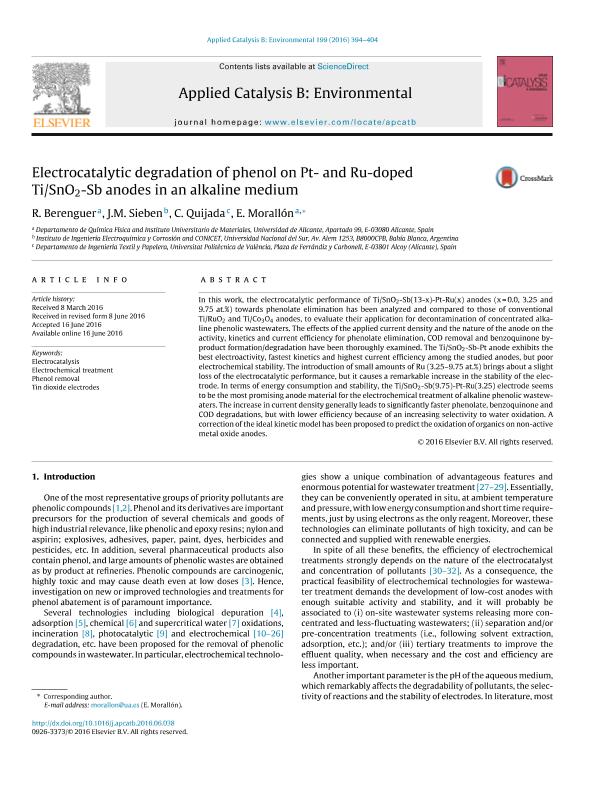Artículo
Electrocatalytic degradation of phenol on Pt- and Ru-doped Ti/SnO2-Sb anodes in an alkaline medium
Fecha de publicación:
15/12/2016
Editorial:
Elsevier Science
Revista:
Applied Catalysis B: Environmental
ISSN:
0926-3373
Idioma:
Inglés
Tipo de recurso:
Artículo publicado
Clasificación temática:
Resumen
In this work, the electrocatalytic performance of Ti/SnO2-Sb(13-x)-Pt-Ru(x) anodes (x = 0.0, 3.25 and 9.75 at.%) towards phenolate elimination has been analyzed and compared to those of conventional Ti/RuO2 and Ti/Co3O4 anodes, to evaluate their application for decontamination of concentrated alkaline phenolic wastewaters. The effects of the applied current density and the nature of the anode on the activity, kinetics and current efficiency for phenolate elimination, COD removal and benzoquinone by-product formation/degradation have been thoroughly examined. The Ti/SnO2-Sb-Pt anode exhibits the best electroactivity, fastest kinetics and highest current efficiency among the studied anodes, but poor electrochemical stability. The introduction of small amounts of Ru (3.25?9.75 at.%) brings about a slight loss of the electrocatalyticperformance, but it causes a remarkable increase in the stability of the electrode. In terms of energy consumption and stability, the Ti/SnO2-Sb(9.75)-Pt-Ru(3.25) electrode seems to be the most promising anode material for the electrochemical treatment of alkaline phenolic wastewaters. The increase in current density generally leads to significantly faster phenolate, benzoquinone and COD degradations, but with lower efficiency because of an increasing selectivity to water oxidation. A correction of the ideal kinetic model has been proposed to predict the oxidation of organics on non-active metal oxide anodes.
Archivos asociados
Licencia
Identificadores
Colecciones
Articulos(CCT - BAHIA BLANCA)
Articulos de CTRO.CIENTIFICO TECNOL.CONICET - BAHIA BLANCA
Articulos de CTRO.CIENTIFICO TECNOL.CONICET - BAHIA BLANCA
Citación
Berenguer Rodríguez, José; Sieben, Juan Manuel; Quijada, C.; Morallón, E.; Electrocatalytic degradation of phenol on Pt- and Ru-doped Ti/SnO2-Sb anodes in an alkaline medium; Elsevier Science; Applied Catalysis B: Environmental; 199; 15-12-2016; 394-404
Compartir
Altmétricas




